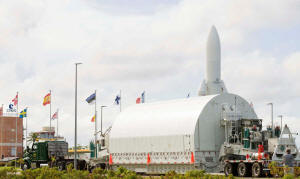NASA's Webb telescope promises an 'amazing journey' for astronomy
 Send a link to a friend
Send a link to a friend
 [December 14, 2021]
By Will Dunham [December 14, 2021]
By Will Dunham
WASHINGTON (Reuters) - It was finished
years late at a cost far higher than planned, but NASA's James Webb
Space Telescope due for launch next week may usher in a new era in
astronomy as it gathers information on the universe's earliest stages,
star formation, and whether planets beyond our solar system may be
suitable for life.
The orbiting infrared observatory, designed to be about 100 times more
sensitive than its Hubble Space Telescope predecessor, is due to blast
off on Dec. 22 on an Ariane 5 rocket from a site in French Guiana on
South America's northeastern coast.
"We're about to go on this amazing journey of discovery," said
astronomer Klaus Pontoppidan, a Webb project scientist the Space
Telescope Science Institute in Baltimore. "We really mean discovery
because Webb has the raw power to reveal the unexpected. We can plan
what we think we're gong to see. But at the end of the day we know that
nature will surprise us more often than not."

The telescope, boasting four scientific instruments, is an international
collaboration led by NASA in partnership with the European and Canadian
space agencies. Northrop Grumman Corp is the primary contractor. The
launch vehicle is part of the European contribution.
It was developed at a cost of $8.8 billion, with operational expenses
projected to bring its total price tag to about $9.66 billion. The U.S.
Government Accountability Office said the price has nearly doubled since
NASA established a cost baseline in 2009 after earlier cost overruns.
NASA had hoped to launch it in 2011, but the date was repeatedly
delayed.
Scientists plan to use the telescope to learn about all phases of the
universe's history dating back to just after the Big Bang event about
13.8 billion years ago, while also studying exoplanets - planets beyond
our solar system - as well as worlds closer to home such as our
planetary neighbor Mars and Saturn's moon Titan.
Webb mainly will look at the universe in the infrared, while Hubble has
examined it since its 1990 launch primarily at optical and ultraviolet
wavelengths. Webb has a much bigger light-collecting area, letting it
look at greater distances, thus farther back into time, than Hubble.
"We're looking forward to this and we're getting very, very close," said
Greg Robinson, Webb's program director at the U.S. space agency's
Washington headquarters.
[to top of second column]
|

NASA’s James Webb Space Telescope rolls to its final stop before
launch from Arianespace's ELA-3 launch complex at Europe’s Spaceport
in French Guiana, on the northeastern coast of South America, as
seen in this NASA image released on November 2, 2021 and obtained by
Reuters on December 13, 2021. NASA/Chris Gunn/Handout via REUTERS

The telescope arrived in French Guiana in October after a 16-day sea
journey from California through the Panama Canal to Port de
Pariacabo on the Kourou River. After launch, it will deploy on a
month-long million-mile (1.6 million km) journey to a more distant
orbit than Hubble, beyond the moon.
"We're going to look at everything there is in the universe that we
can see. We want to know: how did we get here from the Big Bang, how
did that work? So, we'll look," said John Mather, Webb senior
project scientist at NASA's Goddard Space Flight Center in
Greenbelt, Maryland.
Its mission goals include searching for the first galaxies or
luminous objects formed after the Big Bang and learning how galaxies
evolved from their initial birth to the present day.
"We want to look at those first galaxies growing," Mather said.
The goals also include observing the formation of stars and the
planets around them. Mather said Webb can peer into the clouds of
gas and dust where stars are being born. Until now, the dust in
those clouds obscured the view.

"Infrared light will go around the dust grains instead of bouncing
off, so we can see that with the Webb telescope. And that's one of
our top goals - to see how stars grow, with their young planets,"
Mather said.
An instrument called a spectrometer can study the atmospheres of
exoplanets. Mather said finding one with lots of water - thought to
be one of the key ingredients for life - would be "really
interesting." As he put it: "a wet little planet out there that
might be a little bit like home."
(Reporting by Will Dunham, Editing by Rosalba O'Brien)
[© 2021 Thomson Reuters. All rights
reserved.] Copyright 2021 Reuters. All rights reserved. This material may not be published,
broadcast, rewritten or redistributed.
Thompson Reuters is solely responsible for this content. |